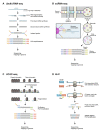Epigenetic Memories in Hematopoietic Stem and Progenitor Cells
- PMID: 35883630
- PMCID: PMC9324604
- DOI: 10.3390/cells11142187
Epigenetic Memories in Hematopoietic Stem and Progenitor Cells
Abstract
The recent development of next-generation sequencing (NGS) technologies has contributed to research into various biological processes. These novel NGS technologies have revealed the involvement of epigenetic memories in trained immunity, which are responses to transient stimulation and result in better responses to secondary challenges. Not only innate system cells, such as macrophages, monocytes, and natural killer cells, but also bone marrow hematopoietic stem cells (HSCs) have been found to gain memories upon transient stimulation, leading to the enhancement of responses to secondary challenges. Various stimuli, including microbial infection, can induce the epigenetic reprogramming of innate immune cells and HSCs, which can result in an augmented response to secondary stimulation. In this review, we introduce novel NGS technologies and their application to unraveling epigenetic memories that are key in trained immunity and summarize the recent findings in trained immunity. We also discuss our most recent finding regarding epigenetic memory in aged HSCs, which may be associated with the exposure of HSCs to aging-related stresses.
Keywords: chromatin accessibility; epigenetic memory; epigenome; hematopoietic progenitor cells; hematopoietic stem cells; innate immune cells; next-generation sequencing.
Conflict of interest statement
The authors declare no conflict of interest.
Figures





References
-
- Buenrostro J.D., Corces M.R., Lareau C.A., Wu B., Schep A.N., Aryee M.J., Majeti R., Chang H.Y., Greenleaf W.J. Integrated Single-Cell Analysis Maps the Continuous Regulatory Landscape of Human Hematopoietic Differentiation. Cell. 2018;173:1535–1548.e1516. doi: 10.1016/j.cell.2018.03.074. - DOI - PMC - PubMed
-
- Netea M.G., Domínguez-Andrés J., Barreiro L.B., Chavakis T., Divangahi M., Fuchs E., Joosten L.A.B., van der Meer J.W.M., Mhlanga M.M., Mulder W.J.M., et al. Defining trained immunity and its role in health and disease. Nat. Rev. Immunol. 2020;20:375–388. doi: 10.1038/s41577-020-0285-6. - DOI - PMC - PubMed
Publication types
MeSH terms
LinkOut - more resources
Full Text Sources

